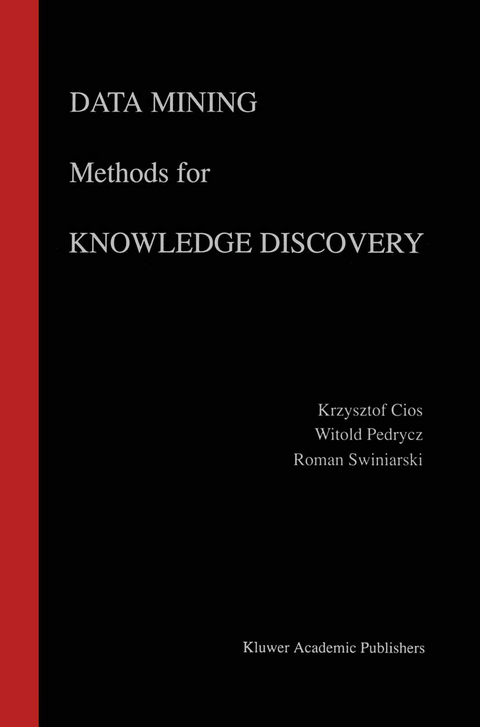
Data Mining Methods for Knowledge Discovery
Springer (Verlag)
978-0-7923-8252-2 (ISBN)
Data Mining Methods for Knowledge Discovery is intended for senior undergraduate and graduate students, as well as a broad audience of professionals in computer and information sciences, medical informatics, and business information systems.
1 Data Mining and Knowledge Discovery.- 1.1 Data Mining and Information Age: Emerging Quests.- 1.2 Defining Knowledge Discovery.- 1.3 Architectures of Knowledge Discovery.- 1.4 Knowledge Representation.- 1.5 Main Types of Revealed Patterns.- 1.6 Basic Models of Data Mining.- 1.7 Knowledge Discovery and Related Research Areas.- 1.8 Main Features of a Knowledge Discovery Process.- 1.9 Coping with Reality. Sampling in Databases.- 1.10 Selected Examples of Knowledge Discovery Systems.- 1.11 Summary.- References.- Additional Readings.- 2 Rough Sets.- 2.1 Introduction.- 2.2 Information System.- 2.3 Indiscernibility Relation.- 2.4 Discernibility Matrix.- 2.5 Decision Tables.- 2.6 Approximation of Sets. Approximation Space.- 2.7 Accuracy of Approximation.- 2.8 Approximation and Accuracy of Classification.- 2.9 Classification and Reduction.- Reduct and Core.- 2.10 Decision Rules.- 2.11 Dynamic Reducts.- 2.12 Summary.- 2.13 Exercises.- References.- Appendix A2: Algorithms for Finding Minimal Subsets.- 3 Fuzzy Sets.- 3.1 Introduction.- 3.2 Basic Definition.- 3.3 Types of Membership Functions.- 3.4 Characteristics of a Fuzzy Set.- 3.5 Membership Function Determination.- 3.6 Fuzzy Relations.- 3.7 Set Theory Operations and Their Properties.- 3.8 The Extension Principle and Fuzzy Arithmetic.- 3.9 Information—Based Characteristics of Fuzzy Sets.- 3.10 Numerical Representation of Fuzzy Sets.- 3.11 Rough Sets and Fuzzy Sets.- 3.12 The Frame of Cognition.- 3.13 Probability and Fuzzy Sets.- 3.14 Summary.- 3.15 Exercises.- References.- 4 Bayesian Methods.- 4.1 Introduction.- 4.2 Basics of Bayesian Methods.- 4.3 Involving Object Features in Classification.- 4.4 Bayesian Classification — a General Case.- 4.5 Statistical Classification Minimizing Risk.- 4.6 Decision Regions. Probabilitiesof Errors.- 4.7 Discriminant Functions.- 4.8 Estimation of Probability Densities.- 4.9 Probabilistic Neural Network (PNN).- 4.10 Constraints in Design.- 4.11 Summary.- 4.12 Exercises.- References.- 5 Evolutionary Computing.- 5.1 Genetic Algorithms. Concept and Algorithmic Aspects.- 5.2 Fundamental Components of GAs 196 Encoding and Decoding.- 5.3 GA. Formal Definition of Genetic Algorithms.- 5.4 Schemata Theorem: a Cnceptual Backbone of Gas.- 5.5 Genetic Computing. Further Enhancement.- 5.6 Exploration and Exploitation of the Search Space.- 5.7 Experimental Studies.- 5.8 Classes of Evolutionary Computation.- 5.9 Genetic Optimization of Rule-Based Description of Data: Pittsburgh and Michigan Approaches.- 5.10 Summary.- 5.11 Exercises.- References.- 6 Machine Learning.- 6.1 Introduction.- 6.2 Introduction to Generation of Hypotheses.- 6.3 Overfitting.- 6.4 Rule Algorithms.- 6.5 Decison Tree Algorithms.- 6.6 Hybrid Algorithms.- 6.7 Discretization of Continuous-Valued Attributes.- 6.7.1 Information-Theoretic Discretization Methods.- 6.8 Hypothesis Evaluation.- 6.9 Comparison of the Three Families of Algorithms.- 6.10 Machine Learning in Knowledge Discovery.- 6.11 Machine Learning and Rough Sets.- 6.12 Summary.- 6.13 Exercises.- References.- Appendix A6: Diagnosing Coronary Artery Disease (CAD).- References.- 7 Neural Networks.- 7.1 Introduction.- 7.2 Radial Basis Function (RBF) Network.- 7.3 RBF Networks in Knowledge Discovery.- 7.4 Kohonen’s Self Organizing Map(SOM)Network.- 7.5 Image Recognition Neural Network (IRNN) 357 Sensory Layer.- 7.6 Summary.- 7.7 Exercises.- References.- Appendix A7: Image Similarity(IS) Measure.- 8 Clustering.- 8.1 Unsupervised Learning: a General Taxonomy and Related Algorithmic Aspects.- 8.2 Hierarchical Clustering.- 8.3 ObjectiveFunction—Based Clustering.- 8.4 Clustering Methods and Data Mining.- 8.5 Hierarchical Clustering in Building Associations in the Data.- 8.6 Clustering under Partial Supervision in Data Mining.- 8.7 A Neural Realization of Similarity Between Patterns.- 8.8 Numerical Experiments.- 8.9 Summary.- 8.10 Exercises.- References.- 9 Preprocessing.- 9.1 Patterns and Features.- 9.2 Preprocessing Operations.- 9.3 Principal Component Analysis — Feature Extraction and Reduction.- 9.4 Supervised Feature Reduction Based on Fisher’s Linear Discriminant Analysis.- 9.5 Sequence of Karhunen-Loeve and Fisher’s Linear Discriminant Projections.- 9.6 Feature Selection.- 9.7 Numerical Experiments — Texture Image Classification.- 9.8 Summary.- 9.9 Exercises.- References.
| Reihe/Serie | The Springer International Series in Engineering and Computer Science ; 458 |
|---|---|
| Zusatzinfo | XXI, 495 p. |
| Verlagsort | Dordrecht |
| Sprache | englisch |
| Maße | 155 x 235 mm |
| Themenwelt | Mathematik / Informatik ► Informatik ► Datenbanken |
| Informatik ► Theorie / Studium ► Algorithmen | |
| ISBN-10 | 0-7923-8252-8 / 0792382528 |
| ISBN-13 | 978-0-7923-8252-2 / 9780792382522 |
| Zustand | Neuware |
| Informationen gemäß Produktsicherheitsverordnung (GPSR) | |
| Haben Sie eine Frage zum Produkt? |
aus dem Bereich


